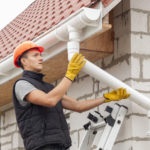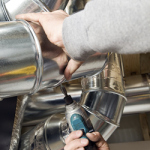 Did you know that HVAC represents about 40% of a building’s total energy consumption? With climate change top of mind for many home-owners, energy-efficient homes with smaller environmental footprints are in demand. First steps are to improve and protect the building envelope. For example, you can help maintain the integrity of the envelope by installing rainscreen-compatible vents and wall caps.
Did you know that HVAC represents about 40% of a building’s total energy consumption? With climate change top of mind for many home-owners, energy-efficient homes with smaller environmental footprints are in demand. First steps are to improve and protect the building envelope. For example, you can help maintain the integrity of the envelope by installing rainscreen-compatible vents and wall caps.
By installing equipment that features low GWP (short for global warming potential) compressors, you can make a big difference to a building’s environmental impact. A low GWP compressor uses refrigerants that are less likely to contribute to global warming.
Until this year, it seemed that government policies would make low GWP compressors the industry standard in North America. But developments in the United States have slowed the transition. Fortunately, many manufacturers plan to continue to transition to low GWP refrigerants.
History of policy changes
In 2015 the Obama administration put forth a proposal to phase out the use of all HFCs (hydrofluorocarbons). The phase-out was to operate under the EPA’s SNAP (Significant New Alternatives Policy) program.
The SNAP program was originally established to oversee the phasing out of ozone-depleting substances. Its mandate came from the U.S. commitment to an international agreement called the Montreal Protocol, which calls for the transition to refrigerants made with HFCs. These have no ozone-depleting qualities but are, as the EPA says, “potent greenhouse gasses.” In 2016, the signatories of the protocol entered into a new agreement called the Kigali Agreement that called for phasing out HFCs.
In August 2017, an appeals court ruled that the EPA cannot compel companies to replace HFCs with low GWP alternatives. The rationale was that SNAP was being extended beyond its original mandate.
The industry responds
The EPA, Honeywell, and Chemours, a chemical company, appealed the decision and on January 26, 2018, an appeals court denied their petition for a new hearing. In a statement quoted on the hydrocarbons website, a spokesperson from Honeywell said:
“Honeywell is deeply disappointed in the Court’s decision not to review the August D.C. Circuit Court of Appeals’ ruling … We believe the Court missed an opportunity to reverse its initial decision, which ignored the original intent of SNAP to direct the Environmental Protection Agency to replace ozone-depleting substances with safer alternatives.”
Honeywell plans to appeal to the Supreme Court as they, and many other HVAC manufacturers, serve the international market, so, must produce equipment that meets all global environmental standards. An example of an international standard is the European Union’s F-Gas regulation, which has a goal of reducing HFCs by 79% by 2030.
Canada is a signatory to the Kigali agreement (the United States is not), and individual states are adopting HFC reduction policies as well. California, for example, has incorporated the SNAP rules around low GWP refrigerants into state law.
Companies like Honeywell, Danfoss, Chemours, Daikin, Trane, and many more are working toward a low GWP future regardless of how court proceedings go. Trane, for example, has a mission to reduce the greenhouse gas emissions of its products to 50% by 2020, and their parent company, Ingersoll Rand plans to transition its entire portfolio of products to low GWP refrigerants by 2030.
How important is this? Well, according to the EPA, as a greenhouse gas, HFCs are a thousand times more potent per pound than carbon dioxide. Phasing out HFCs could reduce global warming by 0.5˚C. Current predictions by the IPCC (Intergovernmental Panel on F-Gas regulation ) is expected to increase global temperatures by up to 5˚C by 2100. So phasing out HFCs could represent a 10% reduction in the global temperature increase.
As an HVAC installer, keep your eye on equipment specs so that you can ensure your customers are part of the low GWP future of this industry.





